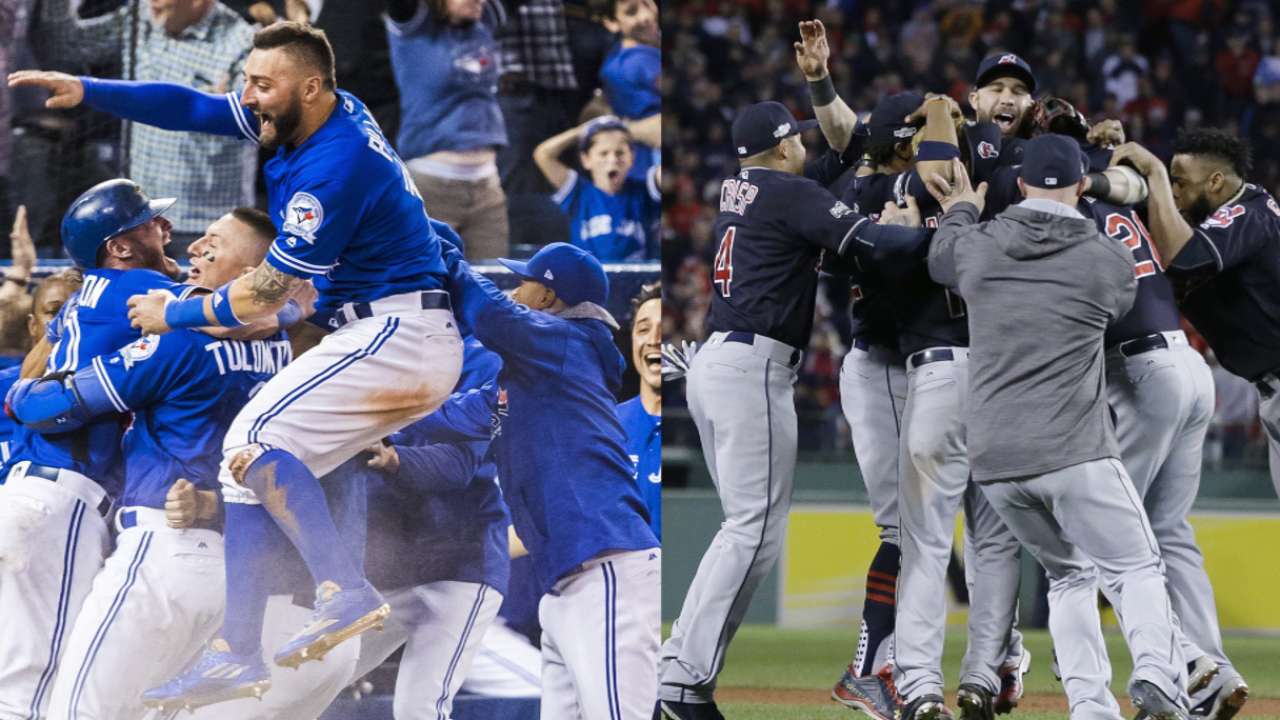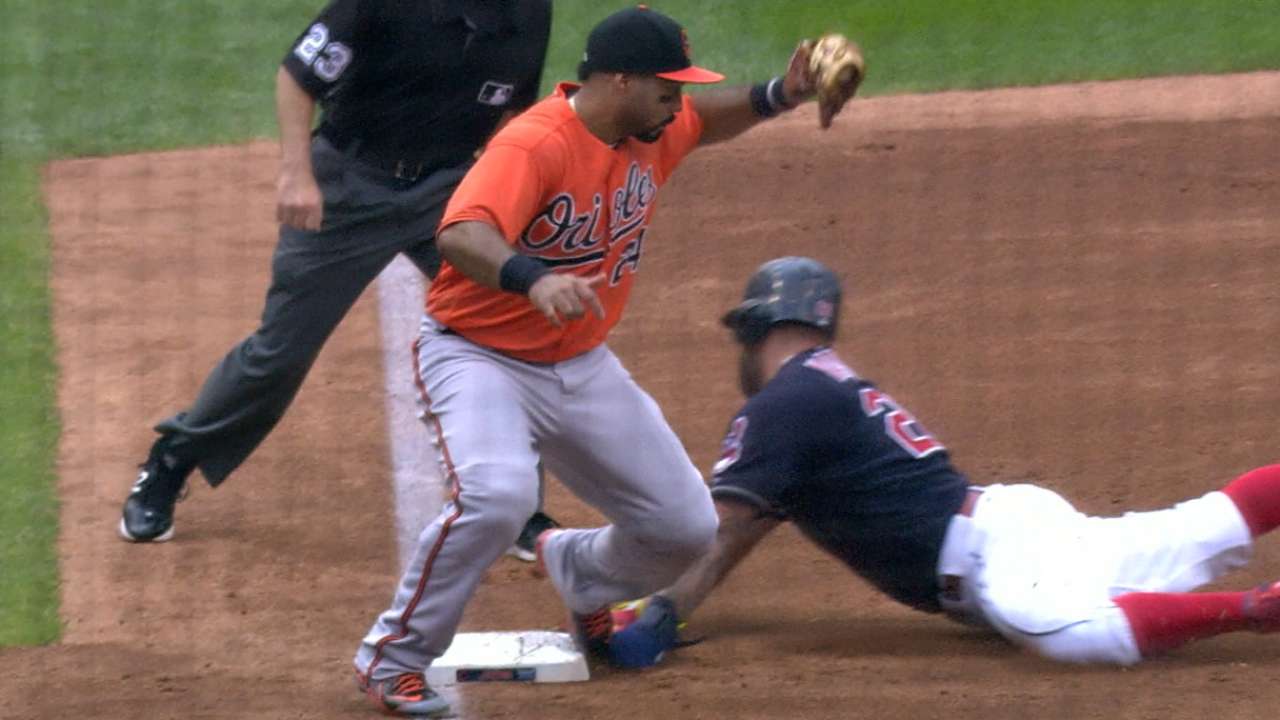Tribe can press big baserunning advantage in ALCS
Cleveland's 134 stolen bases most since 1999 team had 147
By Mike Petriello / MLB.com | @mike_petriello | 4:55 PM ET + 1 COMMENT
In a matchup as tight as the Cleveland vs. Toronto pairing seems to be, little things can make all the difference. That figures to be the case when the American League Championship Series begins on Friday (8 p.m. ET on TBS and, in Canada, Sportsnet and RDS) at Progressive Field.
So while there's understandably plenty of focus on the Blue Jays' edge in the rotation or the Indians' edge in the bullpen or how big of an advantage Kevin Pillar's elite defense provides in the outfield, let's look at the basepaths -- because there's potentially a big strength for Cleveland to exploit against Toronto. The Indians can run wild, and the Blue Jays may not be able to prevent it.
Let's share what we mean ...
Cleveland is outstanding at steals, and Toronto isn't good at stopping them
The Indians quietly stole the most bases in the AL (134), which was their highest total since the 1999 team of Omar Vizquel, Kenny Lofton and Roberto Alomar stole 147. If you prefer looking at success rate rather than raw totals, then manager Terry Francona's team and its 81.2 percent success rate finished second in the Majors only to Arizona, and not by a whole lot (the D-backs were at 81.6 percent). Rajai Davis' 43 steals were the fourth most in the Majors and the most the team had seen since Vizquel's 42 in that '99 season.
So Cleveland likes to run wild on the bases, and that's perhaps a problem for Toronto. The Blue Jays tied for the fewest times catching baserunners stealing (20), and their 19 percent caught-stealing rate (when the Major League average was 28 percent) was the third lowest. Russell Martin threw out just 11 of 72 runners, a 15 percent success rate. You can't blame knuckleballer R.A. Dickey, either; he allowed only two steals all year long.
"Numbers lie," Martin said when asked if he was concerned about Toronto's lack of success throwing out runners this year. "That's why if they want to take their chance, what I'm best at in life is catching and throwing. I don't want to sound overconfident, but it's a big part of my game. So to me, it's a non-issue ...
"Controlling the basepaths is something I've done my whole career, and it's exciting for me. I like when people run. It gives me a challenge, and I love challenges. I hope they run a lot."
Cleveland is outstanding at running the bases in general
There's more to life, and baseball, than just stolen bases. There's taking the extra base on a sacrifice fly. There's going first to third on a single. There's making it home safely from second on a single. There's a lot of important baserunning variables.
Now, there's a few ways to quantify that. There's the simple ways, like noting that Cleveland's Extra Bases Taken percentage was the second best in the Majors (45 percent, when the average was 40 percent) or that no team scored from second on a single more often (129, when the average was 101).
There's also the advanced ways, like FanGraphs' BaseRunning Runs, which accounts for most everything a runner can do on the bases. Cleveland ranks high there as well, coming in third with +17 runs added. Individually, Davis (second) and Jose Ramirez (fifth) were both in the top five, with only the elite Billy Hamilton topping Davis.
"It's not necessarily that they're the fastest," Blue Jays right fielder Jose Bautista said. "They might be good at taking chances and being aggressive, which opens the door for us, if we execute, to throw a lot of them out. Kind of like the situation the Angels run themselves into sometimes.
"I don't think we should change anything. We have pretty good arms in the outfield ... We have to be positioned well, our pitchers have to execute so our positioning can come into play. Hopefully they hit the ball hard enough to where we have a chance to throw them out. And if they want to take those chances, we welcome that and challenge them to do so, because we feel good about our defense."
The Indians are outstanding at turning 90 feet into something shorter
So why are the Indians so successful on the bases? Without question, Cleveland has fast, heads-up runners, but it also does something interesting to help itself -- taking good, strong primary leads, which we can measure with Statcast™.
For example, let's just look at steal attempts to second and see how far off the baserunners were when the pitcher made his first move to the plate. The Major League average for those plays is 11.3 feet, and we have 63 players who have tried at least 10 attempts to look at.
The Indians have three players in the top 15, including Francisco Lindor (fifth, 12.4 feet), Jason Kipnis (10th, 12.2) and Davis (15th, 12). Ramirez also appears at 22nd, with an average lead of 11.8 feet. It helps to be fast, but it also helps to change the rules of the game. You don't have to run 90 feet between bases. You run 90 feet minus however much you can bite off with a lead. Cleveland's runners do just that.
"As long as I don't take too long making the pitch, I don't think too many guys are going to try to steal," Blue Jays Game 1 starter Marco Estrada said. "We've got one of the best catchers behind the plate. So if they want to try to steal, go ahead. Russ, you know, he's got a cannon. He's quick releasing it, he makes accurate throws. So it makes my job that much easier."
Toronto's outfield arms are not a strength
While it's on Martin and Toronto's pitchers to prevent Cleveland from stealing bases, it's on the Blue Jays' outfielders to hold Davis, Ramirez and friends from taking extra bases or running home without fear.
While the Jays do have an elite ground-covering center fielder in Pillar, what they don't have is an outfield well-suited to taking out opposing runners. By an old-school number like assists, Toronto's 25 ranked 23rd, when the average was 29. By a newer metric like FanGraphs' "Arm" rating, which tracks not only assists but also how well an outfielder prevents a runner from even trying to advance, the Blue Jays are, again, 23rd.
And by Statcast™'s arm strengths, we can see that few of the Blue Jays have plus arms in terms of velocity. For example, we saw 16 outfield throws during the regular season that were clocked at 100 mph or more (two by Cleveland's Tyler Naquin), plus two more so far in the postseason. Toronto had only two above 95 mph all season long.
Looking at "competitive throws," the Blue Jays' outfield arms rank 18th, with an average of 88.7 mph. For comparison, Minnesota was the best at 93.4 mph, and Oakland the weakest at 83.6 mph. Given that the Major League average was 89, Toronto ranks about in the middle of the pack. While Melvin Upton Jr. (91.8 mph) leads the pack and Michael Saunders (90.7 mph) and Pillar (90.0 mph) are OK, Ezequiel Carrera (86.9 mph) and -- shockingly, given his reputation, but perhaps not given last year's serious shoulder injury -- Bautista (84.4 mph) can be run on.
This aspect of the game probably won't decide the series on its own. But in a tight pairing where anything can happen, maybe it will. We certainly saw how Josh Donaldson's aggressive baserunning and the inability of the Rangers to prevent it mattered in getting Toronto here in the first place, didn't we?
"You have to play good, smart, clean baseball in the postseason," Pillar said. "I think we've done that so far in the four games that we've played. We've done the little things right. But last year is a huge reminder of how quickly things can turn. One moment you're cruising, you make a mistake, you're looking up the scoreboard and you're losing the game."



